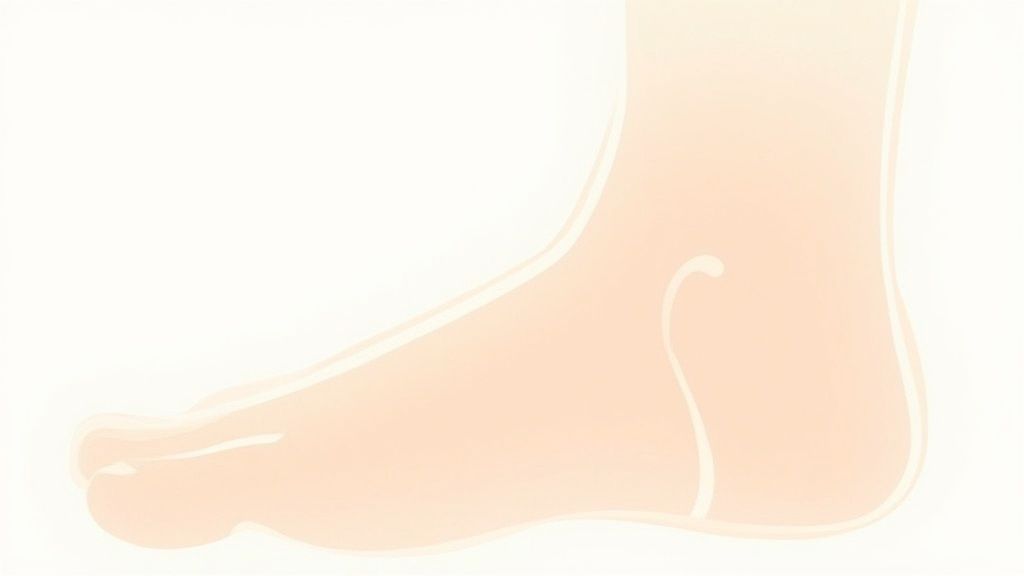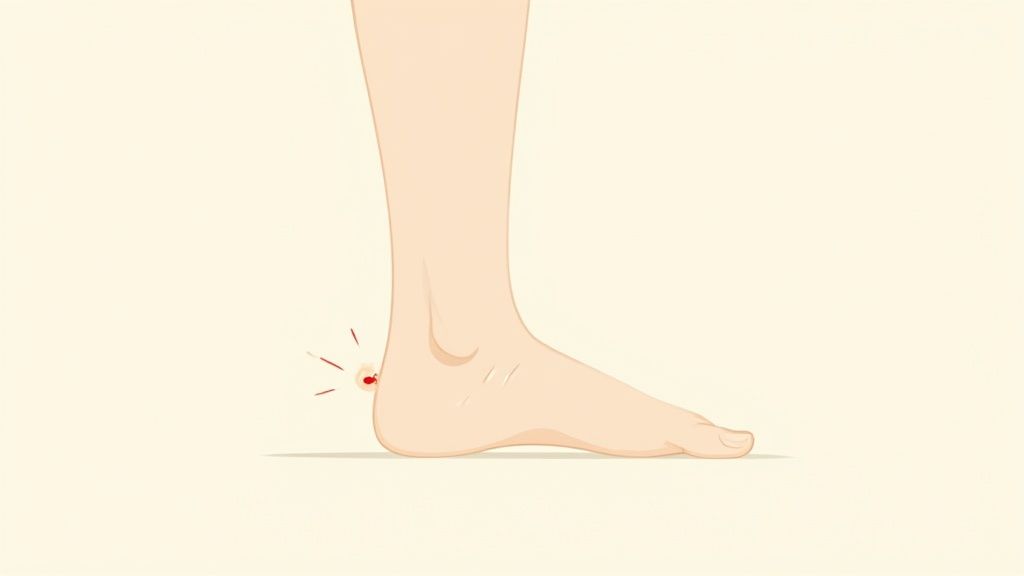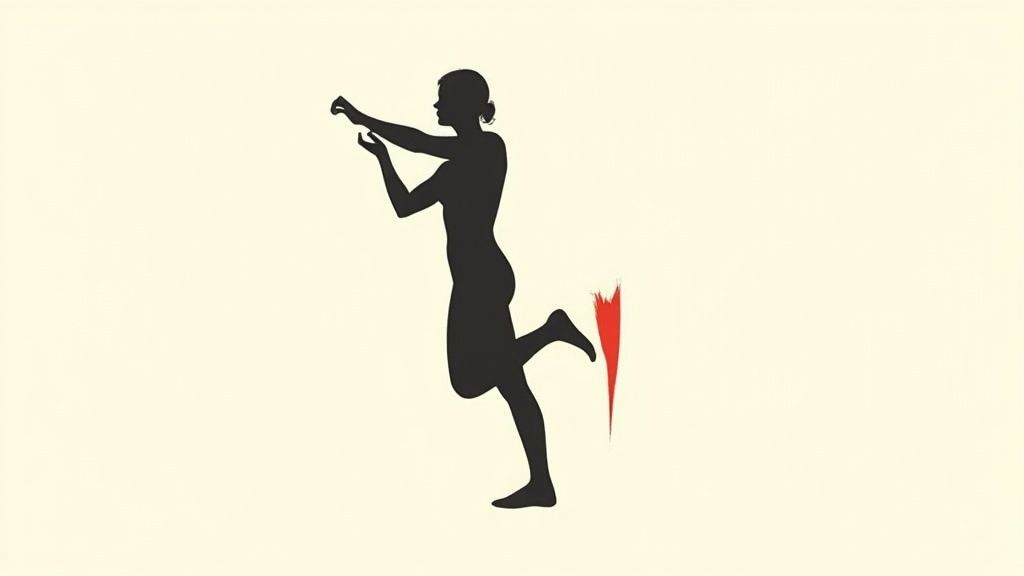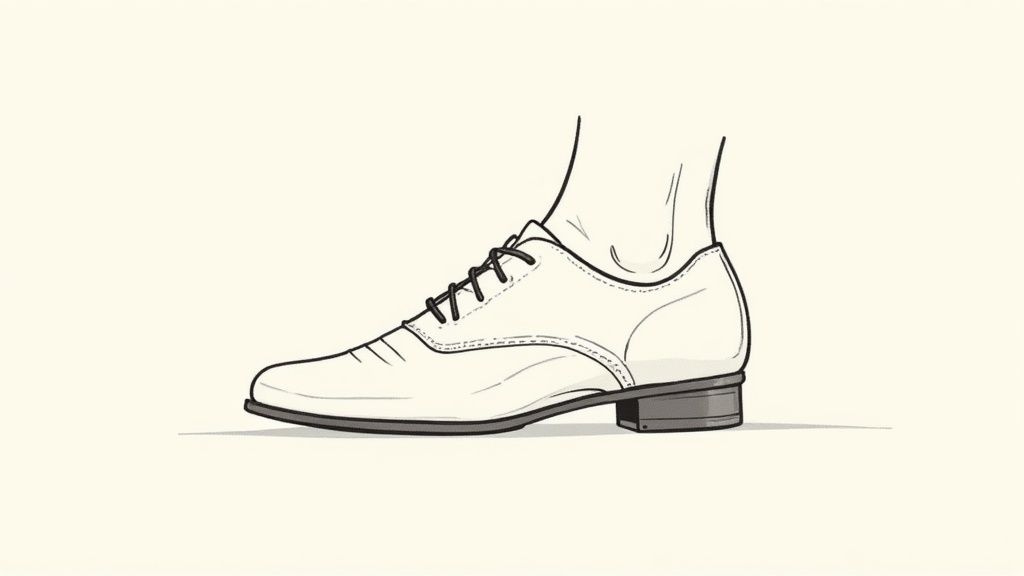Let's talk about that sharp, stabbing pain in your heel. If the first few steps out of bed in the morning feel like you're walking on glass, you've likely met plantar fasciitis. It's the most common reason people have heel pain, and it all comes down to a thick, stubborn band of tissue on the bottom of your foot.
Your First Step Away From Morning Heel Pain

That awful morning pain can be both frustrating and confusing. But once you understand what's actually happening inside your foot, you're on the right path to feeling better.
Think of the plantar fascia as a tough, powerful rubber band stretching from your heel to your toes. Its whole job is to support your arch and absorb the shock of every single step you take. It's a brilliant piece of natural engineering, but even the strongest structures have their limits.
Why Does It Hurt So Much?
The pain starts when that "rubber band" gets overstretched, leading to tiny, microscopic tears. This isn't usually from a single event, but from repetitive strain. Think long hours on your feet, wearing flimsy shoes, or suddenly ramping up your running routine.
Your body's response to these tiny injuries is inflammation, and that inflammation is exactly what causes the pain.
Key Insight: That stabbing sensation isn't random. It’s your body sending a clear signal that the plantar fascia ligament is damaged, inflamed, and crying out for a break.
This also explains why the pain is so much worse in the morning. While you sleep, your foot is relaxed, and the plantar fascia tightens up. When you put weight on it first thing, you're suddenly yanking on that tight, inflamed tissue. Ouch.
To give you a better idea, here's a quick look at the core of the issue.
Plantar Fasciitis At a Glance
| Symptom | Common Cause | Who Is At Risk |
|---|---|---|
| Stabbing pain near the heel | Repetitive strain and micro-tears | Runners, teachers, nurses |
| Pain is worst in the morning | Over-stretching an inflamed ligament | People who stand all day |
| Pain that eases with activity | Ligament warms up and loosens | Individuals with flat feet or high arches |
This table boils it down, but the key takeaway is that plantar fasciitis is an overuse injury. It's not something you did wrong overnight, but rather a gradual breakdown over time.
How Common Is This Condition?
If you're going through this, you're in good company. Plantar fasciitis affects about 1 in 10 people at some point in their lives. In the U.S. alone, it's the reason for about 2 million doctor visits every year and makes up roughly 15% of all foot-related complaints. You can find more details on these plantar fasciitis facts and figures on KURU Footwear.
Knowing that plantar fasciitis is a repetitive strain injury is the first, most important step. It's not a sudden break, but a slow burn. Understanding this is what empowers you to take the right actions—both literally and figuratively—to finally start healing.
How Your Foot's Architecture Causes Pain

To really get what’s going on with plantar fasciitis, we need to look at the incredible design of your foot. It’s more than just a bunch of bones—it's a masterfully engineered structure built to handle a lifetime of steps. At the heart of this design is the plantar fascia, a tough, webbing-like ligament running along the sole of your foot.
Picture your foot's arch as a bow, like one used in archery. The plantar fascia is the bowstring. It stretches from your heel to the balls of your feet, holding everything under tension and giving your arch its shape. This “bowstring” is designed to flex and absorb the shock every time you walk, run, or jump, protecting the rest of your body.
When everything is in balance, this system is flawless. But problems start when we push it too far, too often. Things like standing all day on concrete floors, a sudden increase in running mileage, or wearing flimsy shoes can overload that bowstring.
What’s Happening on a Microscopic Level
When the plantar fascia is constantly overworked, it doesn't just get sore; it actually starts to break down. Think of a rubber band that's been stretched one too many times—it starts to get tiny, almost invisible cracks. That’s precisely what happens inside your foot as micro-tears form in the ligament's fibers.
Your body, ever the diligent repair crew, rushes to fix the damage. It sends inflammatory cells to the site, kicking off the healing process. Here’s the catch: this inflammation is what causes the pain. It’s not the tears themselves you feel, but your body's response to them.
This state is often called fasciosis, a frustrating cycle of injury, inflammation, and incomplete healing. If you don't remove the source of the strain, the fascia never truly gets a break. Over time, the tissue can actually thicken and lose its flexibility, making it even more susceptible to future injury.
The Mystery of Morning Pain, Solved
One of the tell-tale signs of plantar fasciitis is that excruciating pain you feel with your first few steps out of bed. It’s so common, it has its own medical term: post-static dyskinesia.
What This Means: Post-static simply means "after rest," and dyskinesia means "painful or difficult movement." So, it’s pain after being still.
While you're asleep, your feet naturally relax into a pointed position. This allows the inflamed plantar fascia to shorten and tighten up overnight. When you swing your legs out of bed and put weight on your foot, you abruptly stretch that cold, contracted ligament. The result is a sharp, stabbing sensation as those micro-tears are pulled apart.
As you start to move around, the tissue warms up and loosens, which is why the pain usually fades to a dull ache. This distinct pattern of morning pain is a huge clue for doctors and a clear sign that the plantar fascia is the source of your trouble.
How Your Foot Type Plays a Role
The very shape of your feet can make you more likely to develop this condition. It usually comes down to one of two common foot structures:
- Flat Feet (Overpronation): If you have flat feet, your arch tends to collapse inward with every step. This puts the plantar fascia on a constant stretch, pulling and straining it far more than it was designed for.
- High Arches (Supination): On the flip side, very high and rigid arches can also be a problem. A high arch is poor at absorbing shock, so more of the impact from walking and running is transferred directly to the heel and the already tight plantar fascia.
In both cases, the plantar fascia is under constant, excessive stress. Understanding how your unique foot structure deals with daily forces is the first step toward finding relief that’s targeted to your specific needs.
Uncovering the Root Causes of Your Heel Pain

Plantar fasciitis rarely just shows up one morning. It’s almost always the result of a slow burn—a gradual buildup of stress that eventually pushes your plantar fascia ligament past its limit. Getting to the bottom of these triggers is the key to finding real, lasting relief.
Think of your plantar fascia like a rope that can only handle so much tension. Every day, your activities, your body mechanics, and even your shoes add a little more strain. When that cumulative strain becomes too much for the rope to handle, it starts to fray. That's when the pain begins.
So, what’s putting all that pressure on your feet? It's typically not one thing, but a perfect storm of factors. By figuring out what your specific risk factors are, you can start taking the pressure off and give your feet a chance to heal.
Physical and Biomechanical Factors
Sometimes, the way your body is built can predispose you to heel pain. Your unique anatomy dictates how force moves through your feet every time you take a step.
Here are a few of the most common physical culprits:
- Foot Structure: As we mentioned earlier, both flat feet (which cause the arch to collapse and overstretch the fascia) and unusually high arches (which are rigid and absorb shock poorly) create constant tension on that ligament.
- Tight Calf Muscles: This is a big one. When your calves are tight, they pull up on your heel bone, limiting your ankle's flexibility. That tension gets transferred directly to your plantar fascia, basically yanking on it with every single step.
- Weight: It’s simple physics—carrying extra body weight dramatically increases the load on your feet. Each extra pound you carry adds several pounds of pressure to your plantar fascia when you walk or run, speeding up that wear and tear.
These biomechanical quirks lay the groundwork for plantar fasciitis. But often, it's our daily habits that light the fuse. You can dive deeper into how you get plantar fasciitis in our detailed guide on the topic.
Lifestyle and Occupational Triggers
Your job and your hobbies are often where the real damage happens. Certain professions and activities are notorious for causing heel pain simply because they involve the same stressful movements over and over again.
Think about these common examples:
- The Teacher: Standing and walking on hard linoleum floors for hours a day with very few breaks.
- The "Weekend Warrior": Sits at a desk all week, then tries to cram all their activity into a couple of intense days of running or sports.
- The Nurse: Pulling a long 12-hour shift, constantly moving on their feet, often in footwear chosen for safety over support.
Plantar fasciitis plagues over 1 million people worldwide each year, and it's heavily driven by these kinds of lifestyle factors. Research consistently shows that jobs requiring prolonged standing, especially when combined with unsupportive shoes, dramatically increase a person's risk.
The Wrong Gear: Your Shoes
Last but certainly not least, what you put on your feet can make or break your foot health. Your shoes are your primary shock absorbers. When they aren't doing their job, your plantar fascia takes the hit.
Footwear becomes a major problem when it is:
- Worn-Out: Old running shoes have compressed cushioning and offer no real protection.
- Unsupportive: Think flat flip-flops, flimsy ballet flats, or minimalist shoes with zero arch support.
- Ill-Fitting: Shoes that are too tight, too loose, or just the wrong shape for your foot can mess with your gait and create painful pressure spots.
When you combine your natural anatomy with high-stress activities and poor footwear, you create the ideal conditions for plantar fasciitis. The good news? Identifying which of these factors apply to you is the first and most powerful step toward getting out of pain for good.
How Doctors Figure Out What's Wrong With Your Foot

If you've been struggling with heel pain that just won't quit, getting a professional diagnosis is the first real step toward feeling better. It's tempting to play doctor on the internet, but a real evaluation is crucial to confirm what's going on and make sure you aren't dealing with something else entirely.
The good news? Diagnosing plantar fasciitis is usually pretty straightforward. Most of the time, a simple conversation and a hands-on physical exam are all it takes. No fancy or expensive tests needed.
The Power of Your Story: The Exam Process
Your doctor will start by listening. This is where you become the most important part of the diagnostic process. The details you provide are the clues they need to solve the puzzle of your pain.
Be ready to talk about things like:
- Where exactly does it hurt? Point to the spot—is it right under the heel, more in the arch?
- What does the pain feel like? Is it a sharp, stabbing sensation or more of a dull, constant ache?
- When is it the worst? This is a big one. The classic tell-tale sign of plantar fasciitis is that sharp, intense pain you feel with your very first steps out of bed.
After hearing your story, your doctor will do a physical exam. They’ll gently press on your foot to find the precise source of the tenderness. For plantar fasciitis, that spot is almost always where the fascia ligament attaches to the heel bone.
They’ll also check your foot's mechanics—looking for high arches or flat feet—and assess the flexibility of your ankle and calf muscles. They might even watch you walk for a bit to see your gait and spot any issues that could be contributing to the stress on your feet.
Over 90% of cases are diagnosed this way. It's a clinical diagnosis, meaning it’s based almost entirely on your symptoms and the physical exam.
Plantar Fasciitis vs Other Heel Pain
It's easy to assume all heel pain is plantar fasciitis, but other conditions can feel surprisingly similar. Your doctor's job is to differentiate between them. Here’s a quick look at how the symptoms can differ.
| Condition | Key Symptom | Location of Pain |
|---|---|---|
| Plantar Fasciitis | Sharp, stabbing pain with first steps in the morning. | Bottom of the heel, sometimes extending into the arch. |
| Achilles Tendinitis | Pain and stiffness along the back of the heel. | Back of the heel and lower calf. |
| Heel Spur | Often asymptomatic, but can cause localized pain. | Directly under the heel bone (seen on X-ray). |
| Stress Fracture | Deep, aching pain that worsens with activity. | Can be anywhere in the heel bone. |
Understanding these distinctions is why a professional diagnosis is so valuable. Knowing the correct cause leads to the correct treatment.
When Might You Need an X-Ray or MRI?
Most people with plantar fasciitis will never need an imaging test. However, if your symptoms are unusual or aren't getting better with initial treatment, your doctor might order one to rule out other problems.
An X-ray, for example, is great for checking the bones. It can spot things like a stress fracture or arthritis. It can also show bone spurs, but keep in mind that many people have heel spurs without any pain at all, so they aren't always the culprit.
An MRI is even less common. This test gives a detailed picture of soft tissues like ligaments and nerves. A doctor might order one if they suspect you have a tear in the plantar fascia or a pinched nerve causing your symptoms.
Ultimately, your next step is finding the right professional to guide you. When deciding what kind of doctor treats plantar fasciitis, a podiatrist is often your best bet, as they specialize in everything foot-related.
Your Action Plan for Lasting Pain Relief
Knowing you have plantar fasciitis is the first step. Figuring out what to do about it is the real challenge. The key is to have a solid plan, a roadmap that takes you from hobbling in pain to walking freely again. The best approach is layered, starting with simple things you can do at home before moving on to other options if you need them.
Think of it like building a house. You wouldn't put up the walls without first pouring a solid concrete foundation. In the same way, your recovery needs to start with the basics—proven techniques that calm the inflammation and take the strain off your feet.
Tier 1: Foundational Home Care
This first stage is all about putting out the fire in your foot. These are strategies you can start doing right now to get some relief and kickstart the healing process. They don’t require a doctor's visit, they won't break the bank, and they form the core of almost every successful recovery. In fact, more than 90% of plantar fasciitis cases get better with just these simple, conservative treatments.
First up is the classic R.I.C.E. method, a time-tested approach for injuries like this.
- Rest: This one is non-negotiable. You have to cut back on activities that make your foot hurt. That doesn't mean you're sentenced to the couch, but it does mean avoiding high-impact exercise like running and minimizing long hours of standing.
- Ice: Applying ice to the bottom of your heel for 15-20 minutes at a time, a few times a day, is fantastic for numbing the pain and bringing down inflammation. A frozen water bottle is a great hack here—you can roll your foot over it for a gentle massage at the same time.
- Compression: While it's not always the first thing people think of for plantar fasciitis, compression socks can be a big help. They support your arch and can reduce swelling, especially if you have a job that keeps you on your feet.
- Elevation: Whenever you're resting, try to prop your foot up so it's higher than your heart. Gravity will do the work, helping to drain fluid and reduce swelling.
Key Takeaway: Your most powerful tool here is consistency. Doing these simple things every single day sends a clear message to your body that it's time to heal, allowing those tiny tears in your plantar fascia to finally start mending.
Along with R.I.C.E., gentle stretching is absolutely critical. Remember how that fascia band tightens up overnight? Stretching is your way of fighting back. You'll want to focus on two main spots: your calf muscles and the plantar fascia itself. A tight calf tugs on your heel bone, which in turn pulls on the fascia. Loosening up those calves can bring surprisingly fast relief.
Tier 2: Supportive Gear and Orthotics
Once you’ve got a daily routine of rest and stretching down, the next step is to give your feet the outside help they're crying out for. The whole point of this tier is to offload stress from the plantar fascia as you go about your day.
Think of this gear as a temporary support system for your overworked ligament.
- Proper Footwear: It's time to retire those flimsy flip-flops and worn-out sneakers. You need shoes with excellent arch support, a well-cushioned sole, and a bit of a heel lift. This combination absorbs shock better and keeps your foot in a healthier, more neutral position.
- Night Splints: These gadgets might look a little strange, but they work. A night splint holds your foot in a gentle stretch while you sleep, keeping the plantar fascia from tightening up. For many people, this is the secret to getting rid of that awful first-step-in-the-morning pain.
- Orthotic Insoles: This is the real game-changer for so many people. A good pair of over-the-counter insoles designed for plantar fasciitis gives you critical arch support and cushioning exactly where it's needed. They help correct underlying mechanical issues like overpronation (when your foot rolls inward), which is a huge contributor to this condition. If you want to explore more recovery methods, check out our complete guide on how to treat plantar fasciitis.
Tier 3: Professional Medical Help
If you've been diligently trying home care and using supportive gear for a few months and the pain just won't quit, it might be time to bring in a professional. This tier involves getting medical guidance and more advanced interventions from a doctor or physical therapist.
Your healthcare provider might suggest a few things:
- Physical Therapy: A good PT can design a custom program of stretches and exercises to strengthen the small muscles in your feet and lower legs. They also use hands-on techniques like massage to improve your flexibility and knock out the pain.
- Corticosteroid Injections: For really stubborn cases, a doctor might inject a powerful anti-inflammatory steroid directly into the most painful spot. This can provide major relief, but it’s usually seen as a short-term fix, not a permanent cure, so doctors use it carefully.
- Advanced Therapies: There are also newer treatments like Extracorporeal Shock Wave Therapy (ESWT), which uses sound waves to trigger a healing response in the damaged tissue. This is usually only an option after other, more conservative treatments haven't worked.
By starting with Tier 1 and patiently working your way up as needed, you’re following a structured, proven plan to get back on your feet and leave the pain behind.
How to Prevent Heel Pain From Coming Back
Getting out of pain is a huge win, but the real goal is making sure it never comes back. Preventing plantar fasciitis from returning isn’t about a single magic fix. It’s about weaving simple, powerful habits into your daily life. Think of it as building a permanent support crew for your feet so they can keep up with your life.
Your first and most important habit should be a regular stretching routine. Just like you'd stretch before a workout to avoid pulling a muscle, consistent stretching keeps your plantar fascia supple and ready for action. Tight calf muscles are one of the biggest culprits behind heel pain because they constantly tug on your heel, straining the fascia. A simple daily calf stretch against a wall can make an incredible difference.
Smart Daily Habits for Foot Health
Beyond just stretching, your everyday choices have a huge impact. The idea is to cut down on the constant, low-grade stress that caused the inflammation in the first place.
Here are a few key strategies to adopt:
- Choose Supportive Shoes: It's time to say goodbye to those flat, flimsy shoes. Your daily footwear needs to have excellent arch support and plenty of cushioning to absorb the shock of every step. This is your number one defense against strain.
- Maintain a Healthy Weight: Every extra pound you carry puts a surprising amount of pressure on your plantar fascia. Even losing a small amount of weight can dramatically lighten the load on your feet, reducing that daily wear and tear.
- Progress Activities Slowly: If you're excited to start a new fitness routine, that's fantastic! Just resist the temptation to go all-out on day one. Slowly increase how long and how hard you work out to give your feet time to adapt without getting overwhelmed.
For those who spend a lot of time on their feet at work or home, looking into supportive flooring can be a game-changer. You can find out more by reading the 7 Anti Fatigue Mat Benefits You Should Know.
The Big Picture: Prevention is an ongoing commitment, not a temporary project. By making these habits part of your routine, you’re actively protecting your feet from getting hurt again and setting yourself up to stay active and pain-free for years to come.
Your feet carry you through everything. Giving them the consistent support they need is the best way to make sure they can continue their job without complaining. It’s all about being proactive, paying attention to your body, and making smart choices that reward you with every single pain-free step.
Your Top Plantar Fasciitis Questions, Answered
When you're dealing with that relentless heel pain, it’s natural to have a lot of questions. Getting clear, simple answers is the first step toward getting back on your feet—literally. Let's tackle some of the most common things people wonder about.
How Long Does Plantar Fasciitis Take to Heal?
This is the big one, isn't it? The honest answer is: it depends. For most folks with a mild to moderate case, you’re looking at 6 to 10 months to feel significantly better with consistent, smart care. That means daily stretching, using supportive footwear, and taking a break from activities that pound your feet.
But some cases are just more stubborn and can take longer. The absolute most important part of your recovery is consistency. Dipping in and out of your treatment plan won't work. Your inflamed fascia needs a sustained break to truly heal, and a dedicated daily routine is how you give it that.
Can the Wrong Shoes Really Cause This?
Without a doubt. Think of your shoes as the primary shock absorbers for your feet. When they lack proper arch support, have worn-out cushioning, or just plain fit badly, the stress on your plantar fascia skyrockets.
Key Insight: Wearing unsupportive shoes is like driving a car with bad shocks—every little bump feels ten times worse. Regularly wearing flimsy flip-flops, old sneakers, or even certain high heels is a huge contributing factor for many people.
Is It Okay to Exercise with Plantar Fasciitis?
This is a tricky one. You should absolutely avoid any high-impact exercise that causes that sharp, stabbing pain. Trying to "push through it" while running, jumping, or doing high-intensity aerobics will only worsen the tiny tears in the ligament and seriously set back your healing.
Instead, you need to get clever. Switch to low-impact workouts that keep you moving without hammering your feet. Some great options include:
- Swimming
- Cycling
- Using an elliptical machine
- Water aerobics
These activities let you maintain your fitness while giving that inflamed fascia the break it desperately needs to calm down and start repairing itself.
What's the Difference Between a Heel Spur and Plantar Fasciitis?
It’s easy to get these two mixed up. Plantar fasciitis is the inflammation and breakdown of the thick ligament itself. A heel spur, on the other hand, is a small bony growth—a calcium deposit—that can form on the heel bone where the fascia attaches.
Here’s the surprising part: while many people with plantar fasciitis also have heel spurs (they often show up on an X-ray), the spur is almost never the actual source of the pain. The pain comes from the inflamed ligament pulling on that spot. The real key to relief is treating the inflammation in the plantar fascia, not the bony spur.
Tired of dreading that first step out of bed? Samurai Insoles are specifically designed to provide the crucial arch support your feet are missing. They help take the strain off your plantar fascia, putting you on the path to pain-free days. Find your perfect fit at samuraiinsoles.com and feel the difference for yourself.



